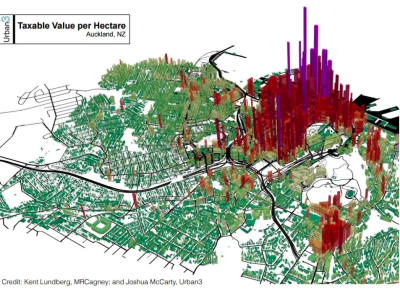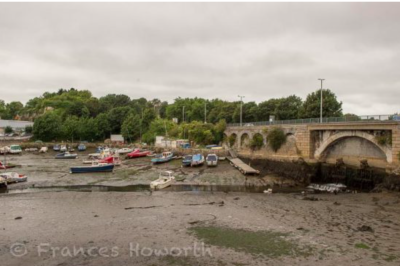Wellington LTP submission guide: from up sh*t creek to longer-term better
It’s LTP season, and Wellington City’s version of the council budgeting challenge has had more scrutiny than most. Here’s the bigger context for all LTPs (plus some TW submission tips for Wellington City-ites)
Infrastructure x density
Ahh, infrastructure.
It’s the foundation (literally) of functioning cities, where lots of people can live close together – generating all the amazing human potential of diversity and interaction, without drowning in mud, dying of vile diseases, losing homes and property to fire, or annoying each other so much things get homicidal.
How we’ve done urban infrastructure – especially in the last 50-60 years – is less “casting a long shadow” over New Zealand’s public-sector planning and aspirations for urban places, than “making a tectonic-scale skew” underneath it. As we try to improve or grow our cities, we’re perpetually pushing sh*t uphill.
For lots of insightful detail on this, see Te Waihanga – the Infrastructure Commission’s research. But for the basic underpinning problem – urban infrastructure financing – almost everything comes down to a very basic calculation.
For any given hectare of the town or city, how much tax revenue can authorities get, versus the costs of the infrastructure needed to serve that space? (ie “provide the services such that in a building on that hectare the lights, internet, stormwater and sewage all work, so you can get to it pleasantly and easily, you can readily enjoy surrounding goodness like nice green-space and a strong neighbourhood community”.)
Can the hectare wash its own face financially – i.e. cover the maintenance and repair costs of its own infrastructure? Is it generating more revenue (hooray!), or breaking even (phew!), or generating less? (aargh!)
Check out this picture of the Auckland city isthmus – it’s not hard to spot which bits are which!

Note: this tectonic-level calculation is agnostic about what kind of public entity is collecting the revenue, and spending it to run and maintain the assets. You can do that more or less efficiently, with different models, but underpinning it all is how much taxable, valuable activity is going on in that serviced hectare.
It all comes down to density. For cities and towns, density is destiny!
[Sidebar: City authorities should, of course, make sure enough of that incoming revenue is actually spent on properly maintaining and upgrading the infrastructure, versus on other things. If councillors consistently defer spending on looking after and upgrading infrastructure (like pipes!), well… say no more.
But if a city’s landuse is too sprawling, even the most diligent council is doomed, fiscally, because of that implacable basic calculation: taxable goodness per hectare vs infra costs per hectare.]
There’s a fresh report out, showing exactly this for Wellington.

(Click the image to go to the report.)
And for some great explainers of this phenomenon see the videos below: part 1 (below), part 2, and part 3.( Watch them on Nebula (with a big discount!) to be ad-free, and support the content-makers directly!)
For “American cities” you can swap in “any New Zealand city or town”. It’s THE SAME SITUATION.
So what on earth can Wellingtonians say about WCC’s LTP?
The government’s canned the Three Waters proposals, and is now heading for a sort of water deal with the Wellington region’s centres. Great, but it’s still just rejigging what entity is responsible for owning, running and maintaining the water infrastructure servicing those sprawling hectares.
Wonderfully, Wellington city has recently seen the end of a crucial barrier to getting denser in its landuse. Huge! But while the rest of the development ecosystem reacts (in a few years, if Auckland’s anything to go by), what should this 2024-34 LTP do?
Some guidance (YMMV)
The spending on water, insurance and so on is solid. So it’s about what gets cut, and how.
When you’re up sh*t creek, do you make a paddle by pulling boards and rivets out of the hull of your canoe, or by repurposing the sunshade/rain-shelter?
Assuming you, dear readers, are not in Charlotte’s position [PDF], our suggestions for a submission are along these lines:
- Don’t cut low-cost high-return things just for the optics
- It’s time to sweat all the assets, no asset class is sacred
- Financial moderation: we’re open to a wee bit more borrowing and a wee bit more rates rise
More on these below – have a read then go through the list of proposals (see the right-hand side of the page for detail on stuff).
You can email in a submission, just make sure it includes the basics of:
- name
- address
- phone number
- whether you want to submit in person too (highly recommended, and we can help if you want!)
- whether you’re submitting as an individual or on behalf of an organisation
You can also use their online form.
And just get it done by midnight Sunday 12th May!
It’s time to sweat all the assets. No asset class is sacred (looking at you, roading)
Especially sweat-worthy: road-corridor assets, in town centres and residential areas. There’s loads of smarter, cheaper ways to make these valuable bits of public space work harder for communities – but councils tend to be loath to consider them because they generally involve “making it a little more annoying to drive or park a car there”.
Things like: getting traffic to 30kph in centres instead of building cycle lanes. Putting temporary “slow zones” at intersections and other high-wear areas of streets to defer their resealing (while making them safer, and easier to cross!). Turning street parking on arterials into bus lanes. Mainstreaming Play Streets instead of having to build new suburban parks (which is really easy and cheap now)… and more. All are good, but need encouragement! (And while it’s not a roading thing: making existing parks more multi-use, like making parts of them skatable, is a great way to sweat a park asset.)
It’s worth saying some stuff about this in some of the “any comments” boxes, if you don’t see an opportunity to express it elsewhere.
And make sure you say Hooray for the proposals on charging for parking, and congestion charging! They’re great asset-sweaters by encouraging people to use street carparks, and drive into the city at peakiest peak time, when they really want to do so, not cos it’s “meh, it’s free“.
Don’t cut low-cost high-return things just for the optics
Don’t be fooled by the virtue-signalling of councillors who call low-cost, high-return initiatives “nice to haves” and say they should be cut “to pay for pipes”, while knowing these initiatives would save meaningless amounts of money in pipes terms yet their absence will be a Very Bad Thing. Classic examples: cycle lanes, traffic-calming near schools, facilitation of Business Improvement Districts. By this stage in the LTP development, most* of the line items that libertarians like to decry as “nice to haves” and “council not sticking to its knitting” have already been really hard-fought.
Financial moderation: we’re open to a wee bit more borrowing and a wee bit more rates rise.
If you’re submitting in person too (awesome! It’s way more impactful) and are worried a councillor will ask something like “well that’s very nice but how do you suggest we pay for that?”, and you want to provide a financial direction (which regular citizens don’t have to!), you have options.
Where the important thing you want to save is operational spending, encourage council to add on an extra 0.X% to the rates rise (cos again, the difference between 17.5% and 18% is a small increase per household when considered across a year, but means a lot for those low-cost, high-return activities). [Obviously, if you are in Charlotte’s position, you don’t have to say this!]
Where the important thing is capital spending (physical stuff), encourage council to borrow a tad more – cos again, the low-cost high-value thing will be a mere wafer on the giant tower of pipes debt, and all this will be changing massively as soon as government and councils reorganise the three-waters landscape.
Please share any good submissions or guides you’ve seen – pop the info in the comments!
Image credits:
- banner – the original “up Sh*t Creek without a paddle” – apparently in Plymouth, England! Credit Frances Howarth
- Auckland revenue x hectare – Urban3, GreaterAuckland

Leave a comment